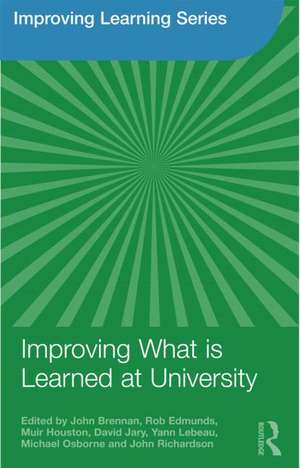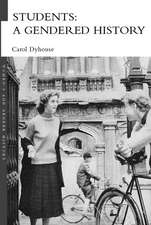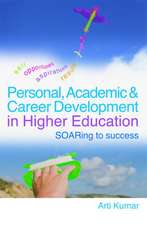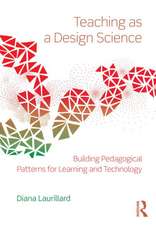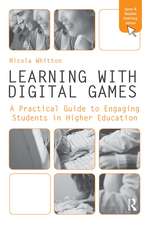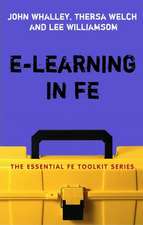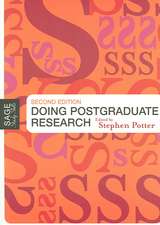Improving What is Learned at University: An Exploration of the Social and Organisational Diversity of University Education: Improving Learning
Autor John Brennan, Robert Edmunds, Muir Houston, David Jary, Yann Lebeau, Michael Osborne, John T.E. Richardsonen Limba Engleză Hardback – 4 ian 2010
What is learned in universities today? Is it what students expect to learn? Is it what universities say they learn? How far do the answers to questions such as these differ according to what, where and how one studies?
As higher education has expanded, it has diversified both in terms of its institutional forms and the characteristics of its students. However, what we do not know is the extent to which it has also diversified in terms of ‘what is learned’. In this book, the authors explore this question through the voices of higher education students, using empirical data from students taking 15 different courses at different universities across three subject areas – bioscience, business studies and sociology. The study concentrates on the students’ experiences, lives, hopes and aspirations while at university through data from interviews and questionnaires, and this is collated and assessed alongside the perspectives of their teachers and official data from the universities they attend.
Through this study the authors provide insights into ‘what is really learned at university’ and how much it differs between individual students and the universities they attend. Notions of ‘best’ or ‘top’ universities are challenged throughout, and both diversities and commonalities of being a student are demonstrated. Posing important questions for higher education institutions about the experiences of their students and the consequences for graduates and society, this book is compelling reading for all those involved in higher education, providing conclusions which do not always follow conventional lines of thought about diversity and difference in UK higher education.
| Toate formatele și edițiile | Preț | Express |
|---|---|---|
| Paperback (1) | 390.25 lei 6-8 săpt. | |
| Taylor & Francis – 3 dec 2009 | 390.25 lei 6-8 săpt. | |
| Hardback (1) | 989.45 lei 6-8 săpt. | |
| Taylor & Francis – 4 ian 2010 | 989.45 lei 6-8 săpt. |
Din seria Improving Learning
-
 Preț: 450.47 lei
Preț: 450.47 lei -
 Preț: 332.34 lei
Preț: 332.34 lei -
 Preț: 302.75 lei
Preț: 302.75 lei -
 Preț: 390.94 lei
Preț: 390.94 lei -
 Preț: 414.55 lei
Preț: 414.55 lei -
 Preț: 428.73 lei
Preț: 428.73 lei -
 Preț: 383.17 lei
Preț: 383.17 lei -
 Preț: 394.98 lei
Preț: 394.98 lei - 13%
 Preț: 287.78 lei
Preț: 287.78 lei -
 Preț: 390.25 lei
Preț: 390.25 lei -
 Preț: 375.33 lei
Preț: 375.33 lei - 13%
 Preț: 289.66 lei
Preț: 289.66 lei - 17%
 Preț: 239.32 lei
Preț: 239.32 lei -
 Preț: 403.74 lei
Preț: 403.74 lei -
 Preț: 377.41 lei
Preț: 377.41 lei -
 Preț: 382.33 lei
Preț: 382.33 lei -
 Preț: 375.33 lei
Preț: 375.33 lei - 18%
 Preț: 983.97 lei
Preț: 983.97 lei -
 Preț: 389.30 lei
Preț: 389.30 lei -
 Preț: 389.30 lei
Preț: 389.30 lei -
 Preț: 386.21 lei
Preț: 386.21 lei -
 Preț: 427.89 lei
Preț: 427.89 lei
Preț: 989.45 lei
Preț vechi: 1206.64 lei
-18% Nou
Puncte Express: 1484
Preț estimativ în valută:
189.42€ • 194.81$ • 157.14£
189.42€ • 194.81$ • 157.14£
Carte tipărită la comandă
Livrare economică 19 februarie-05 martie
Preluare comenzi: 021 569.72.76
Specificații
ISBN-13: 9780415480154
ISBN-10: 0415480159
Pagini: 256
Ilustrații: 26 tables and 11 line drawings
Dimensiuni: 138 x 216 x 16 mm
Greutate: 0.63 kg
Ediția:1
Editura: Taylor & Francis
Colecția Routledge
Seria Improving Learning
Locul publicării:Oxford, United Kingdom
ISBN-10: 0415480159
Pagini: 256
Ilustrații: 26 tables and 11 line drawings
Dimensiuni: 138 x 216 x 16 mm
Greutate: 0.63 kg
Ediția:1
Editura: Taylor & Francis
Colecția Routledge
Seria Improving Learning
Locul publicării:Oxford, United Kingdom
Cuprins
@contents: Selected Contents: Part 1 1. Commonalities and diversities of UK universities John Brennan and David Jary 2. The social and organisational mediation of university learning John Brennan, David Jary, John T.E. Richardson and Mike Osborne Part 2 3. The universities: cultures, organisations and reputations John Brennan, Mike Osborne and David Jary 4. The subjects: tribes and territories David Jary, Robert Edmunds, Muir Houston and Yann Lebea 5. The students: backgrounds, lifestyles and forms of engagement David Jary, Muir Houston and Yann Lebeau 6. What students learned at university John T.E. Richardson and Robert Edmunds 7. What else students learned at university John Brennan, David Jary and Muir Houston 8. Diversities and commonalities in the student experience Mike Osborne, John Brennan and Robert Edmunds Part 3 9. Implications for institutions, academic staff and students David Jary and Mike Osborne 10. Implications for society John Brennan Appendix Methods used in the study John T.E. Richardson, Robert Edmunds
Notă biografică
John Brennan is Professor of Higher Education Research at the UK Open University and Director of the Centre for Higher Education Research and Information.
Rob Edmunds is a Research Student in Systems Engineering and Human Factors at Cranfield University in the UK.
Muir Houston is Lecturer in Adult and Continuing Education in the Faculty of Education at the University of Glasgow, UK.
Davis Jary is Visiting Professor in the Centre for Higher Education Research and Information at the UK Open University
Yann Lebeau is Lecturer in Educational Research in the School of Education and Lifelong Learning at the University of East Anglia, UK.
Michael Osborne is Professor of Adult and Lifelong Education in the Faculty of Education at the University of Glasgow, UK
John Richardson is Professor of Student Learning and Assessment in the Institute of Educational Technology at the UK Open University
Rob Edmunds is a Research Student in Systems Engineering and Human Factors at Cranfield University in the UK.
Muir Houston is Lecturer in Adult and Continuing Education in the Faculty of Education at the University of Glasgow, UK.
Davis Jary is Visiting Professor in the Centre for Higher Education Research and Information at the UK Open University
Yann Lebeau is Lecturer in Educational Research in the School of Education and Lifelong Learning at the University of East Anglia, UK.
Michael Osborne is Professor of Adult and Lifelong Education in the Faculty of Education at the University of Glasgow, UK
John Richardson is Professor of Student Learning and Assessment in the Institute of Educational Technology at the UK Open University
Recenzii
'Part II is the heart of this book, covering the following topics: universities, subjects, students, what students learned, what else students learned, the diversities and commonalities in the student experience. The book was well organized.' - Dian-fu Chang, Higher Education, 2011
There is indeed a real need for this book and the market is likely to be strong. It is the first of its kind for the UK and a sorely needed contribution that will capture the recent and growing interest in the broader student experience in higher education. It will attract considerable interest in the UK and Australia as it directly addresses the issue of institutional diversity and what that means for institutional performance.
The work of the Open University team fills a significant gap in UK higher education research. As the authors note, there has been a long tradition of research and publication of this kind in the United States, but that does not always translate so well to the contexts of Commonwealth and European readers. A leading UK publication on the student experience is long overdue.
There is plenty of evidence of the potential interest in this work. For example, the student experience was the foundational focus of the Higher Education Academy, it was the theme for a recent special edition of the European Journal of Education, and now features as a track and special interest group for the European Association of Higher Education annual conferences.
I agree with the author’s assessment of the range of categories of readership, with the exception of prospective students, although their advisors would certainly be interested. I think the growing market of administrative and support staff in universities and colleges is underestimated. As strategic policy and administrative and support staff become more professionalized with specialist qualifications, they are increasingly looking to scholarly publications of this kind as a source of guidance. The growth of the European Association of Higher Education, and the OECD Institutional Management in Higher Education (IMHE) suggests the market for the book will expand.
This book would also have a strong appeal to the Australian market where the Carrick Institute is following a similar program to the Higher Education Academy. Likewise, the student experience has featured in government and university policy developments in New Zealand.
My recent experience in Asia, and Japan especially, suggests that the market for the book will be significant there as their higher education systems compete more vigorously for international students and universities adapt to the needs of global and highly mobile students.
2. Student market
I imagine that the student market will be small but growing quite significantly in the near future. It includes increasing numbers of postgraduate students in the field of higher education in the UK, and also in Asia. There will be considerable interest in some of the less parochial research centres in the US.
There is a new ‘student’ market emerging in the form of academic staff undertaking coursework and research diploma programs in teaching and learning in higher education. In the UK and Australia these are now either compulsory or at least expected for new academic staff and this book would be of considerable interest.
3. A reasonable price?
Around 25- 30 Pounds?
4. The principal competitive books available and particular advantages of the proposed new book.
There is no obvious competition for this book in the UK, Commonwealth or Europe. The last work of any substance on the student experience in the UK was a collection of chapters, edited by Haselgrove, published in 1994. The major US works on the impact of college on students are by Pascarella and Terenzini, and by Kuh. In my view they are not direct competitors. I would not be surprised if other books are on the way as this subject continues to attract interest from governments and universities.
5. How quickly is this book likely to become out of date?
This book should have a substantial shelf-life – at least 8-10 years.
6. Is the author a recognised authority in this field?
The lead author John Brennan is one of the most highly regarded scholars in higher education studies in the UK and Europe. I am familiar with the work of three of the other authors and they all add value to the research and publication.
7. Coverage of the subject
The subject is more than adequately covered.
8. Do you recommend that we should publish this book?
Yes. Definitely.
Craig McInnis
1. The book idea is promising because it would be the first of its kind in Europe which provides an in-depth empirical insight in the ways students experiences the various academic climates in individual departments/study programmes at universities in a select number of study fields. This is more interesting than handbooks, "how to teach" books, general reflections of the role of teaching in universities and other documents available. The background of a thorough study provides authority and rich material for such a study.
The book would be most interesting for teachers at universities, current and potential students and higher education experts in the UK, because it addresses the UK situation.
It would be interesting in the US as well because there is a large number of higher education programmes in which issues of this kind are trained.
In other countries, higher education experts and as well as some teachers interested in international comparison are potential readers. Given the spread of English as lingua franca, interest could be raised through targeted marketing.
2. The book would be text book only in a select number of study programmes in the area of higher education. It can address students successfully if it is advertised as book guiding them for choices of programmes or getting involved reforms at individual departments.
3. It would be good if there was a price making it attractive to be purchased by individual teachers and individual students (paperback for at most 20 British Pounds).
4. This book would fill a gap in the UK and Europe. As argued above, I do not see a competitive books.
5. According to prior research, we know that academic climates do not change as quickly as for example quantitative developments of entry to higher education, labour markets for graduates etc.
6. The author is highly appreciated as one of the top 10 higher education researcher in Europe. His writing a very good mix of academic respectable and easy to read texts for a broad audience. He is one of the few scholars in the field who took series a balance of publication style addressing both the academic peers and the wider audience of policy makers and practitioners.
7. Cf. 6.
8. Yes, I would recommend it strongly.
9. I believe that this project is the one or at among the few most important results of policy initiatives in the UK to ensure that the teaching and learning function of universities does not get downgraded amidst the increased craze about world-class research universities. Therefore, it should be published well.
Professor Ulrich Teichler
International Centre for
Higher Education Research
University of Kassel
34128 Kassel, Germany
teichler@incher.uni-kassel.de
There is indeed a real need for this book and the market is likely to be strong. It is the first of its kind for the UK and a sorely needed contribution that will capture the recent and growing interest in the broader student experience in higher education. It will attract considerable interest in the UK and Australia as it directly addresses the issue of institutional diversity and what that means for institutional performance.
The work of the Open University team fills a significant gap in UK higher education research. As the authors note, there has been a long tradition of research and publication of this kind in the United States, but that does not always translate so well to the contexts of Commonwealth and European readers. A leading UK publication on the student experience is long overdue.
There is plenty of evidence of the potential interest in this work. For example, the student experience was the foundational focus of the Higher Education Academy, it was the theme for a recent special edition of the European Journal of Education, and now features as a track and special interest group for the European Association of Higher Education annual conferences.
I agree with the author’s assessment of the range of categories of readership, with the exception of prospective students, although their advisors would certainly be interested. I think the growing market of administrative and support staff in universities and colleges is underestimated. As strategic policy and administrative and support staff become more professionalized with specialist qualifications, they are increasingly looking to scholarly publications of this kind as a source of guidance. The growth of the European Association of Higher Education, and the OECD Institutional Management in Higher Education (IMHE) suggests the market for the book will expand.
This book would also have a strong appeal to the Australian market where the Carrick Institute is following a similar program to the Higher Education Academy. Likewise, the student experience has featured in government and university policy developments in New Zealand.
My recent experience in Asia, and Japan especially, suggests that the market for the book will be significant there as their higher education systems compete more vigorously for international students and universities adapt to the needs of global and highly mobile students.
2. Student market
I imagine that the student market will be small but growing quite significantly in the near future. It includes increasing numbers of postgraduate students in the field of higher education in the UK, and also in Asia. There will be considerable interest in some of the less parochial research centres in the US.
There is a new ‘student’ market emerging in the form of academic staff undertaking coursework and research diploma programs in teaching and learning in higher education. In the UK and Australia these are now either compulsory or at least expected for new academic staff and this book would be of considerable interest.
3. A reasonable price?
Around 25- 30 Pounds?
4. The principal competitive books available and particular advantages of the proposed new book.
There is no obvious competition for this book in the UK, Commonwealth or Europe. The last work of any substance on the student experience in the UK was a collection of chapters, edited by Haselgrove, published in 1994. The major US works on the impact of college on students are by Pascarella and Terenzini, and by Kuh. In my view they are not direct competitors. I would not be surprised if other books are on the way as this subject continues to attract interest from governments and universities.
5. How quickly is this book likely to become out of date?
This book should have a substantial shelf-life – at least 8-10 years.
6. Is the author a recognised authority in this field?
The lead author John Brennan is one of the most highly regarded scholars in higher education studies in the UK and Europe. I am familiar with the work of three of the other authors and they all add value to the research and publication.
7. Coverage of the subject
The subject is more than adequately covered.
8. Do you recommend that we should publish this book?
Yes. Definitely.
Craig McInnis
1. The book idea is promising because it would be the first of its kind in Europe which provides an in-depth empirical insight in the ways students experiences the various academic climates in individual departments/study programmes at universities in a select number of study fields. This is more interesting than handbooks, "how to teach" books, general reflections of the role of teaching in universities and other documents available. The background of a thorough study provides authority and rich material for such a study.
The book would be most interesting for teachers at universities, current and potential students and higher education experts in the UK, because it addresses the UK situation.
It would be interesting in the US as well because there is a large number of higher education programmes in which issues of this kind are trained.
In other countries, higher education experts and as well as some teachers interested in international comparison are potential readers. Given the spread of English as lingua franca, interest could be raised through targeted marketing.
2. The book would be text book only in a select number of study programmes in the area of higher education. It can address students successfully if it is advertised as book guiding them for choices of programmes or getting involved reforms at individual departments.
3. It would be good if there was a price making it attractive to be purchased by individual teachers and individual students (paperback for at most 20 British Pounds).
4. This book would fill a gap in the UK and Europe. As argued above, I do not see a competitive books.
5. According to prior research, we know that academic climates do not change as quickly as for example quantitative developments of entry to higher education, labour markets for graduates etc.
6. The author is highly appreciated as one of the top 10 higher education researcher in Europe. His writing a very good mix of academic respectable and easy to read texts for a broad audience. He is one of the few scholars in the field who took series a balance of publication style addressing both the academic peers and the wider audience of policy makers and practitioners.
7. Cf. 6.
8. Yes, I would recommend it strongly.
9. I believe that this project is the one or at among the few most important results of policy initiatives in the UK to ensure that the teaching and learning function of universities does not get downgraded amidst the increased craze about world-class research universities. Therefore, it should be published well.
Professor Ulrich Teichler
International Centre for
Higher Education Research
University of Kassel
34128 Kassel, Germany
teichler@incher.uni-kassel.de
Descriere
This book provides a unique insight into ‘what is really learned at university’ and how much it differs between students and between the universities they attend, challenging notions of ‘best’ or ‘top’ universities.
